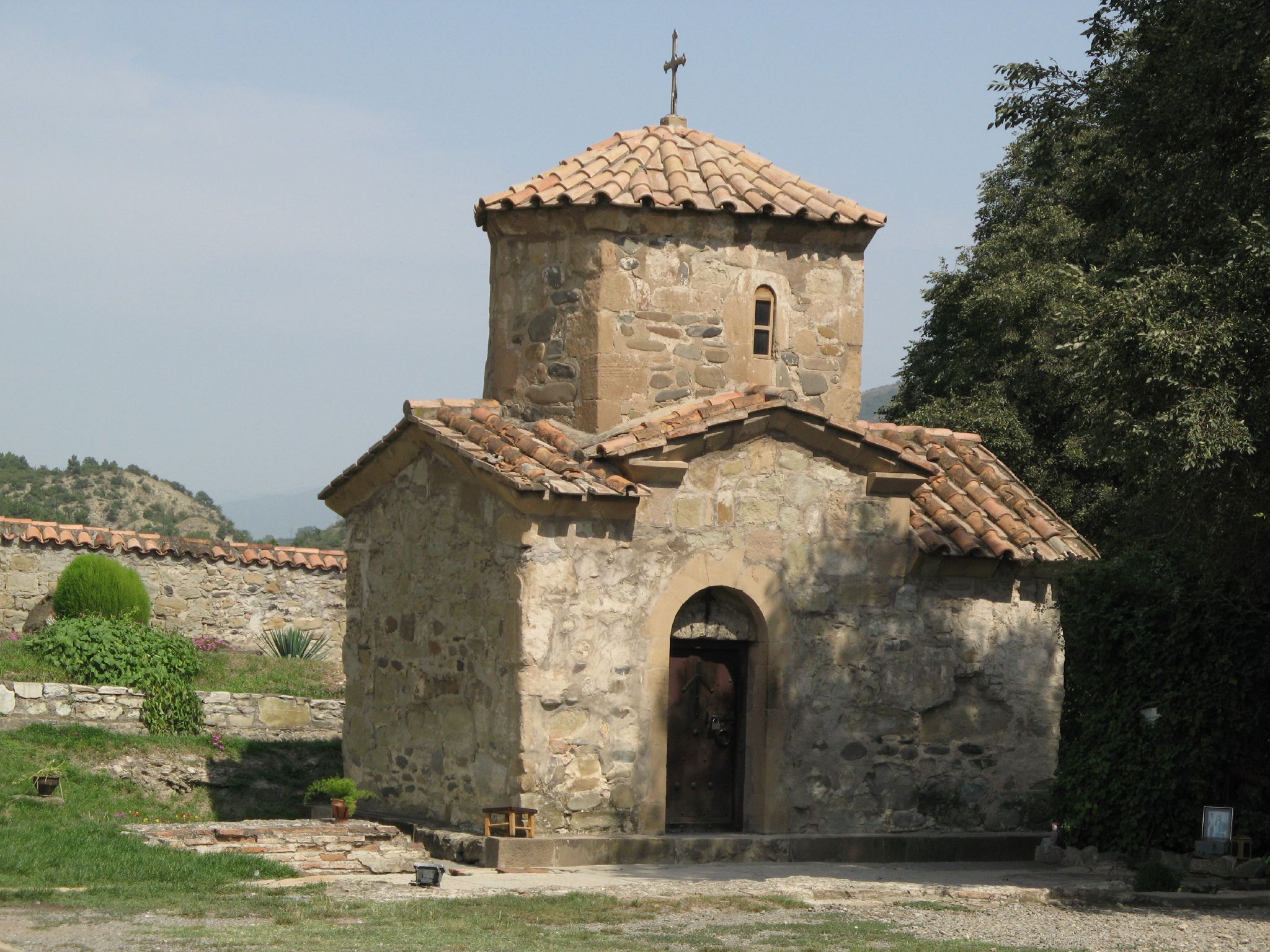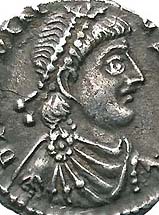After the fall of Stilicho in A.D. 408, the Roman empire had decided to secure military assistance from a non-Germanic source and made a treaty with the Huns, which included the exchange of hostages. One of these was a young Roman named Aetius. By A.D. 425 he had been freed, but his familiarity with the Huns prompted the usurper John (or Joannes), who was in desperate need of military help to ward off an attack at Ravenna, to send Aetius to the Huns with the objective of hiring an army.

Unfortunately for John, Aetius arrived too late to save him, but Aetius was later successful in persuading the Huns to leave Italy in return for booty and hostages. As a result of this remarkable diplomacy, Placidia and Valentinian III forgave him for fighting against them and gave
 him an imperial title.
him an imperial title.In A.D. 432, Aetius lost to his rival Boniface of Africa in a battle fought near Ariminum. Though he returned to his estate, he maintained enough military strength to preclude an open attack from his enemies. However, Boniface’s son-in-law, Sebastian, attempted to have Aetius assassinated. The failed attempt on his life prompted Aetius to leave his estates and he eventually found his way to the Huns, ruled at that time by Rua. Aetius made a treaty with the Huns in which he handed over Pannonia Prima and also sent his own son, Carpilio, as a hostage. With his new Hun allies, Aetius secured his own position in the Empire and faced down Sebastian, becoming a patrician. He turned repeatedly to his Hun allies to assist him in protecting Gallo-Roman interests.
The Destruction of the First Burgundian Kingdom
Aetius often pitted barbarians against each other for the benefit of Rome. This policy was common, as Roman Emperors were reticent to rely on Roman armies because of a fear of civil war. Imperial authorities had long forbidden men of senatorial rank from joining the army and relied upon the populace in the cities to keep the economy moving. As a result, most of the city and country population of the Roman Empire had nothing to do with the military and the best, and only, recruits left were the barbarians.
The Burgundians were one of the first Germanic tribes against whom Aetius marched, with the goal of preventing their further encroachment on Roman soil. Hydatius wrote, “The Burgundians, who had rebelled, were defeated by the Romans under the general Aetius.” According to Prosper of Aquitaine, “Aetius crushed [Gundahar], who was king of the Burgundians and living in Gaul. In response to his entreaty, Aetius gave him peace, which the king did not enjoy for long. For the Huns destroyed him and his people root and branch.” Various other chronicles put the date of these events in the same approximate time frame, and all lay the defeat of the Burgundians at the feet of Aetius and the Huns.

That Aetius and the Huns both attacked the Burgundians has not been disputed. Whether the Huns proceeded with their attack at the bidding of the Roman general, or did so for other reasons, remains unknown. A comparison of the accounts given in the chronicles only adds to the confusion. Hydatius credited Aetius, or forces under his command, for defeating the Burgundians in both A.D. 436 and A.D. 437, while another anonymous chronicler only mentioned that Aetius was responsible defeating the Burgundians in A.D. 436 and made no mention of a second confrontation. Yet, it was the aforementioned account of Prosper of Aquitaine, who lived during the time of the events, which may provide a hint as to what really occurred.
Prosper clearly separated the two attacks upon the Burgundians as well as those responsible. This does not exclude the possibility that the Huns were acting on behalf of Aetius. If true, then it seems likely that Aetius broke his peace with the Burgundians and their spectacular defeat could have resulted from a mistaken belief that they were at peace. In short, they weren’t prepared for war, especially in a weakened state. However, another interpretation of Prosper’s account would indicate that the two separate attacks were committed by different forces and implies differing motivations on the part of each aggressor. Aetius’s motivation was clear. He sought to protect the Gallic aristocracy from Burgundian encroachment. The reasons behind a Hunnic attack are more difficult to determine.
It has been suggested that the Huns may have had their own reasons for attacking the Burgundians. Some contemporary writers wrote that a portion of the Burgundians had not crossed the Rhine with the bulk of their people. Instead, they remained on the eastern shore of the Rhine, in the region between it, the Main, and the Neckar rivers. According to the ecclesiastical historian Socrates, around A.D. 430, these Burgundians were suffering continuous attacks by the Huns, with devastating results.
Apparently, they spurned their traditional, but ineffective, gods and turned to the Christian god for help. According to the story, their prayers were answered when Uptar, the king of this branch of the Huns, exploded, and subsequently died, as a result of a night of overindulgence. (The death of the Arian heretic Arius is another example of this kind of expiration, though Arius could be said to have "shat himself to death", so to speak. Taking Socrates’ examples, it seems prayers were often answered with this sort of explosive result!). Uptar's leaderless tribe of 10,000 was then easily defeated by a force of only 3,000 Burgundians. Finally, because of this stunning victory, the Burgundians became devout Christians.
While this is undoubtedly a conversion story, some details are verified in other sources. Uptar is probably the same person as Octar, the brother of Rua, king of the Huns, who assisted Aetius. Additionally, the relatively small number of warriors engaged in the battle was notable given that the account was written by an ecclesiastical historian, clerics usually given to inflating the size of medieval military forces! Given this, it can be theorized that a group of Huns, led by the brother of Rua, regularly ravaged the Burgundians but were eventually, and unexpectedly, defeated by their one-time victims. As such, the acts later attributed to the Huns, whether singly or at the behest of Aetius, may have been the result of a desire for revenge. However, and perhaps more simply, it could also be a case of a strong Hun army attacking a weak neighbor for booty and treasure. They would not have needed the blessing, or prompting, of Aetius to embark on such a campaign.
Regardless of their motivation, the Huns were effective in reducing the Burgundians “to manageable dimensions, the manner in which this was done becoming a main theme of bardic recitation.” It was such a remarkable event that it was mentioned by several of the extant chroniclers. This “bardic recitation” eventually became known as the Nibelungenlied. As such, the fall of the Burgundians may have inspired legend, but whether the Huns caused their downfall remains a subject for debate. Finally, the encounter with the Huns may have not only inspired an epic tale, but also, shortly after this time (according to some archaeologists), the Burgundians began to emulate the look of their conquerors as they copied Hunnic fashion and even practiced cranial deformation (though that was not a uniquely "Hun" thing to do).
UP NEXT: Germanic Myth and the Burgundians
SOURCES:
E.A. Thompson, A History of Attila and the Huns (London: Oxford University Press, 1948; reprint, Westport, Conn.: Greenwood Press, 1975), 65 (page citations are to the reprint edition).
Musset, Germanic Invasions.
Hydatius, in Murray, Merovingian Gaul.
Prosperi Tironis, in Murray, Merovingian Gaul.
Chronicle of 452, in Murray, Merovingian Gaul.
Walter Goffart, “Rome, Constantinople, and the Barbarians,” The American Historical Review 86, no.2 (1981).
H. Baynes, “A Note on Professor Bury’s ‘History of the Later Roman Empire’,” The
Journal of Roman Studies 12 (1922).
Socrates, vii, 30, in Thompson, A History of Attila and the Huns.
Socrates Scholasticus, The Ecclesiastical History of Socrates Scholasticus, in Socrates and Sozomenus: Ecclesiastical Histories, rev. A.C. Zenos, A Select library of Nicene and post-Nicene fathers of the Christian church : Second series, ed. and trans. Philip Schaff and Henry Wace, vol. 2, (New York: The Christian Literature Company, 1890).
J.M. Wallace-Hadrill, The Barbarian West, 400-1000 (Oxford: Blackwell Publishers Inc., 1999).




